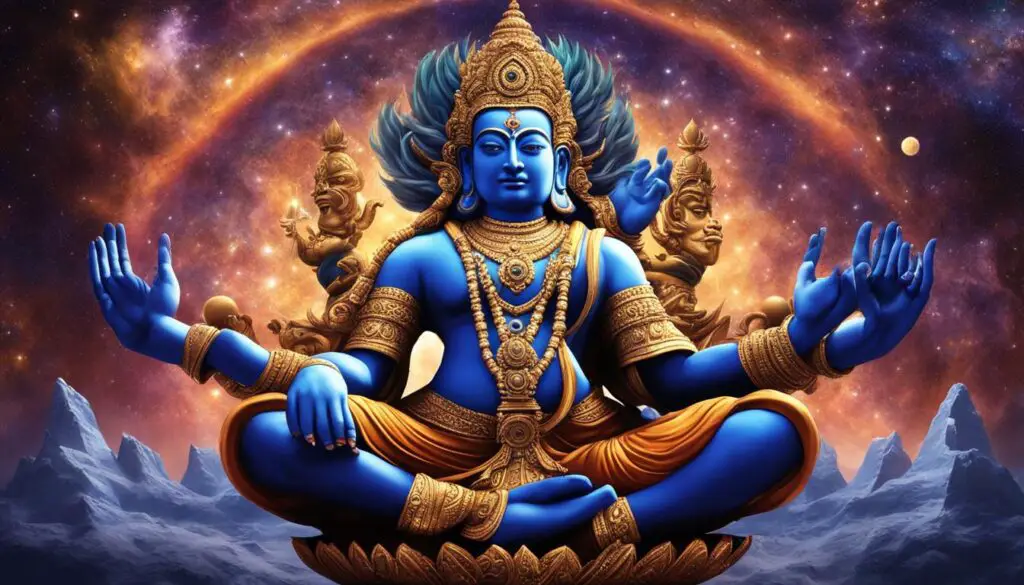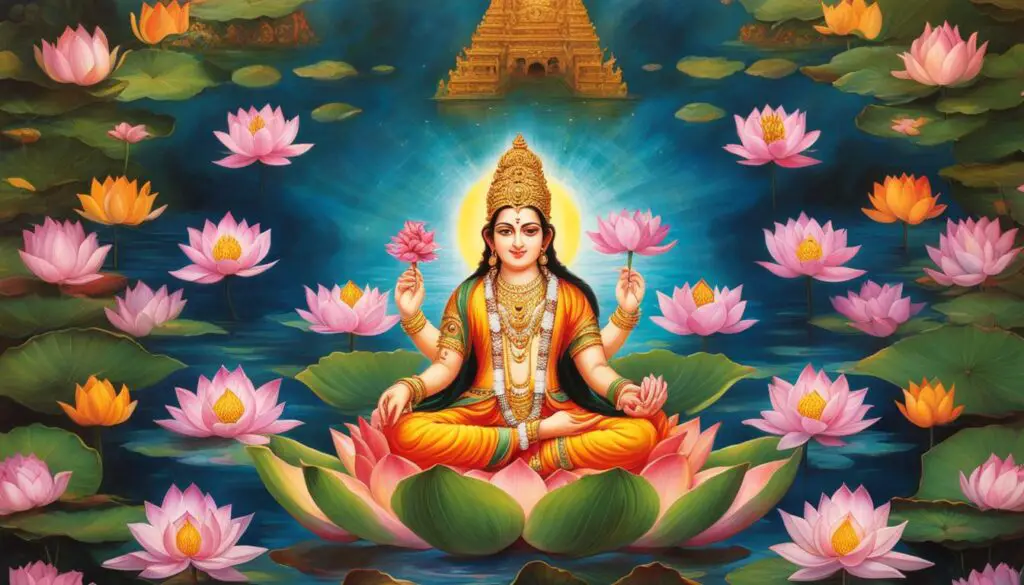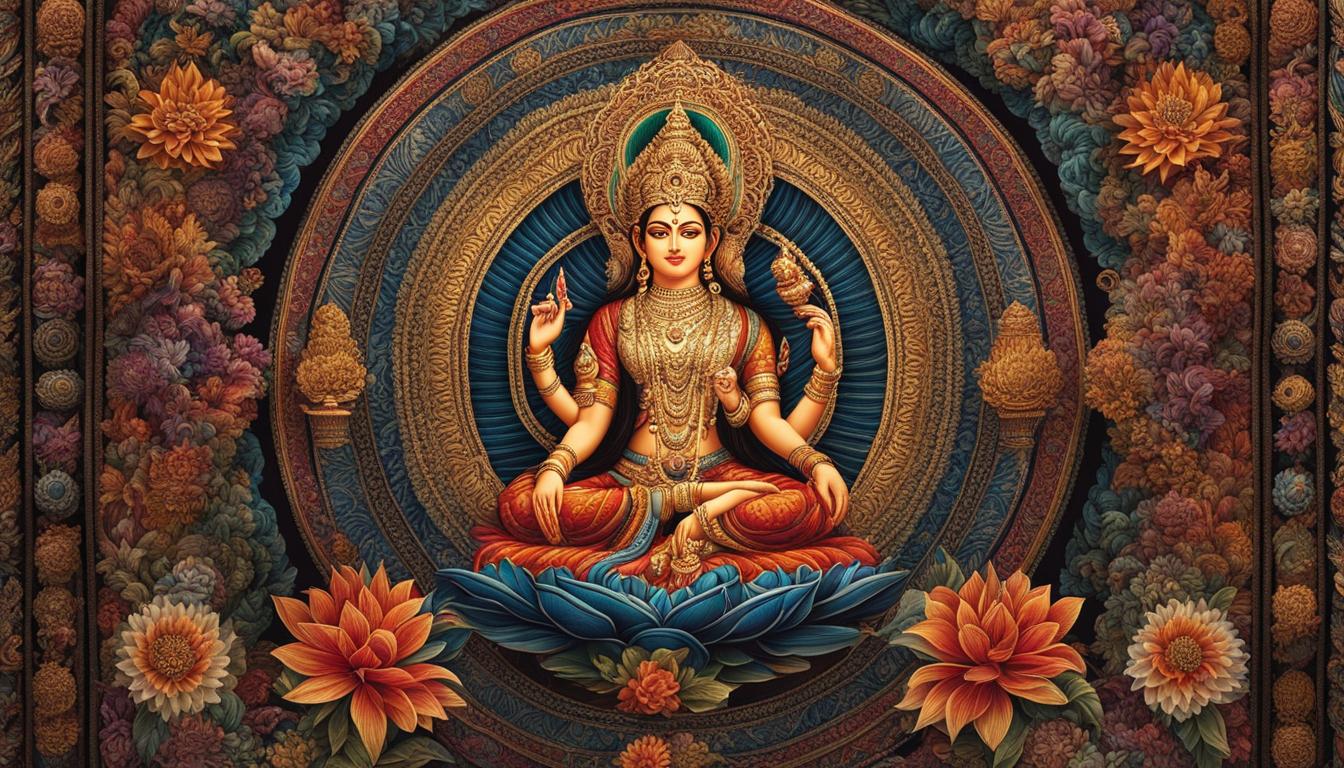Hindu mythology is replete with stories of gods and goddesses, each with their own unique characteristics and attributes. Among them, Brahma stands out as the creator deity, responsible for bringing the universe into existence. But did you know that Brahma also has many names, each significant in its own right? In this section, we’ll explore the various names of Brahma and uncover their hidden meanings in Hindu mythology.
Key Takeaways:
- Brahma is the creator deity in Hindu mythology and has many names.
- Each of Brahma’s names carries deep symbolism and spiritual significance.
- Exploring the names of Brahma can offer insight into the rich mythology and philosophy of Hindu culture.
- Understanding Brahma’s various names is integral to comprehending his importance in shaping the Hindu worldview.
Brahma – The Creator of the Universe
In Hindu mythology, Brahma is known as the creator of the universe. According to legend, he rose from the lotus petals that sprouted from Lord Vishnu’s navel and was tasked with the creation of the entire cosmos. With four faces representing the four cardinal directions and four arms holding a veda, a rosary, a lotus, and a kamandalu (water pot), Brahma is a figure of immense power and significance.
The creation story of Brahma varies from region to region, but they all share the central theme of his divine creation. It is through his wisdom, knowledge, and creativity that the universe came into existence.
“From his lotus navel sprang up to form both worlds, along with its mountains and oceans and all that it contains” – Shiva Purana
Not only did Brahma create the universe, but he also created all living beings that populate it. From humans to animals, insects to birds, and everything in between, all owe their existence to the creator deity.
The Role of Brahma in Hindu Cosmology
In Hindu cosmology, Brahma’s creation is just one of many cycles of creation and destruction that occur in the universe. Known as kalpas, these cycles mark the passage of time and the evolution of the cosmos.
Brahma is the first deity in the Hindu Trimurti, which includes Vishnu and Shiva. While Brahma is the creator, Vishnu is the preserver, and Shiva is the destroyer. Together, these three gods represent the cycle of birth, life, and death in Hindu cosmology.
The Mythology of Brahma’s Divine Creation
There are several myths and legends surrounding Brahma’s creation of the universe. One of the most well-known is the story of how Brahma created the four Vedas, which contain the sacred knowledge of Hinduism.
According to legend, Brahma was originally a formless deity who desired to create the universe but did not know how. One day, he heard a mysterious voice instructing him to perform a yajna (sacrifice) using his own body. When Brahma did this, out of his body emerged the four Vedas – Rigveda, Yajurveda, Samaveda, and Atharvaveda. These texts contain the knowledge and hymns that would guide humanity towards spiritual enlightenment.
| Symbolism of Brahma’s Four Faces | Representation |
|---|---|
| The name of God, or the sound of creation (AUM) | Brahma’s face in the east |
| The power of mental creation and wisdom | Brahma’s face in the south |
| The divine function of preservation, nurture, and sustenance | Brahma’s face in the west |
| The implementation and execution of the laws of nature | Brahma’s face in the north |
Each face of Brahma has a specific symbolism and meaning. The eastern face symbolizes the name of God, or the sound of creation (AUM), which represents the start of life. The southern face represents the power of mental creation and wisdom, and the western face represents the divine function of preservation, nurture, and sustenance. The northern face represents the implementation and execution of the laws of nature.
Brahma’s role as the creator of the universe is essential to Hindu mythology and philosophy. His divine creation represents the birth of life and civilization, and his wisdom and knowledge continue to guide humanity towards enlightenment.
Brahma – The Grandfather of Gods
In Hindu mythology, Brahma is revered as the grandfather of all gods. He is regarded as the first progenitor, who created the universe and all living beings, including other deities.
“Brahma, the Grandfather of all that exists, has always been and always will be. He is the first cause, the ultimate reality, and the source of all creation.”
According to the legends, Brahma was born from a cosmic egg and was the first deity to be born. He is often depicted with four heads, each representing one of the four Vedas, the Hindu scriptures that he created.
| Attribute | Depiction |
|---|---|
| Symbolism | Brahma’s four heads represent his vast knowledge and wisdom |
| Depiction |  |
Brahma’s significance as the grandfather of gods lies in his progenitor role, as he created the first generation of gods and goddesses. He is often associated with the god of preservation, Vishnu and the god of destruction, Shiva, forming the Hindu triumvirate.
Creativity and Wisdom
Brahma is also revered for his creativity and wisdom. As the creator god, he is responsible for the creation and sustenance of the universe. His association with knowledge and wisdom is highlighted through the many stories of his creation of the Vedas, the primary scriptures of Hinduism, and his role as their protector.
In Hindu culture, Brahma is worshipped on special occasions, especially on the festival of Navratri, which is dedicated to the worship of the divine feminine and the triumph of good over evil.
Through his significance as the grandfather of gods and the creator deity, Brahma occupies a unique place in Hindu mythology and philosophy, symbolizing the ultimate source of all that exists and the embodiment of creativity, knowledge, and wisdom.
Brahma – The Four-Faced God
Brahma, the four-faced god in Hindu mythology, represents the different aspects of the divine creator. Each face represents a distinct quality, symbolising the omniscience and omnipresence of Brahma.
The first face of Brahma represents wisdom and is known as the Hamsa. The second face, Vishwaraj, represents cosmic consciousness, while the third face, Tatpurusha, represents the supremacy of Brahma. The fourth and final face, Ardhanarishvara, represents the union of masculine and feminine divinity.
The symbolism associated with each face of Brahma is significant in Hindu mythology. The four faces also represent the four Vedas, which are the sacred texts of Hinduism that Brahma is believed to have created. The Vedas contain the knowledge necessary for spiritual enlightenment and are considered the ultimate source of divine guidance.
“The four faces of Brahma represent the unity and diversity of the divine and reflect the many aspects of creation.”
Brahma – The Lotus-Born Deity
One of the most fascinating stories in Hindu mythology revolves around the birth of Brahma from a lotus flower. According to legend, the universe was once shrouded in darkness until Brahma emerged from a giant lotus that sprouted from the navel of Lord Vishnu, the preserver of the universe. This unique birth gives Brahma the title of the ‘lotus-born deity.’
The lotus flower also carries deep symbolism in Hindu culture, signifying purity, enlightenment, and the continuous cycle of birth and rebirth. The lotus is often depicted in Hindu art and architecture, including the iconic Lotus Temple in New Delhi, India.
Furthermore, Brahma is also associated with the lotus flower in his four faces, which represent the four Vedas, the sacred texts of Hinduism. Each Veda is believed to have originated from one of Brahma’s faces, illustrating his connection to divine knowledge and creation.

“The lotus springs from the water, grows in the water, and rises above the water to stand as a symbol of high aspiration.”
– Sri Chinmoy
Brahma – The Ultimate Reality
Brahma is not only the creator of the universe but also considered the ultimate reality, or Brahman, in Hinduism. The concept of Brahman encompasses the entirety of existence, including both the physical and metaphysical aspects of reality. Brahman is viewed as the eternal, unchanging, infinite, and all-pervading essence that underlies the entire universe.
This ultimate reality can be realized through spiritual practices, including meditation and yoga, which aim to transcend the limitations of the physical world and connect with the essence of Brahman within oneself. This connection is believed to bring about a state of enlightenment, which frees the individual from the cycle of birth and death and leads to ultimate liberation, or Moksha.
“Brahman is the ultimate reality behind everything. It is the eternal, unchanging, infinite and all-pervading essence that supports and underlies everything.”
The idea of Brahman has been interpreted and described in various ways by different schools of Hindu philosophy. Some consider Brahman to be a personal deity, while others see it as an impersonal force beyond human comprehension. Regardless of the interpretation, the concept of Brahman plays a central role in Hindu spiritual teachings.
The Relationship Between Brahma and Brahman
The relationship between Brahma and Brahman can be a bit confusing to understand. While Brahma is the creator deity and one of the three major gods in Hinduism, Brahman is the ultimate reality that underlies the entire universe.
However, some interpretations suggest that Brahma is a manifestation of Brahman, representing its creative power and its ability to bring forth the physical universe from its inherent potentiality. In this sense, Brahma can be seen as the embodiment of Brahman’s creative force and a symbol of its dynamic nature.
Key Concepts related to Brahman in Hindu Philosophy
| Concept | Description |
|---|---|
| Atman | The individual soul that is believed to be a part of Brahman and individuality is considered an illusion. |
| Maya | The illusion of the universe and the material world that superficially appears as real. |
| Karma | The law of cause and effect that determines the consequences of actions. |
| Moksha | The ultimate goal of Hindu spiritual practice, which is liberation or freedom from the cycle of birth and death. |
The idea of Brahman is not just a philosophical concept but also a practical one that impacts the daily life of Hindus. The understanding of Brahman can help individuals to realize their true nature, detach from worldly desires, and attain spiritual liberation.
Brahma – The Creator of Sacred Scriptures
As the creator of the universe and the grandfather of all gods in Hindu mythology, Brahma played a crucial role in shaping the spiritual and philosophical principles of Hindu culture. However, beyond his roles as a supreme deity, Brahma is also known for his significant contribution to literature through the creation of sacred scriptures.
In Hindu mythology, it is believed that Brahma imparted divine knowledge to humankind through the writing of various texts, including the four Vedas, which form the basis of Hindu philosophy and ritual. These texts are said to contain practical knowledge and wisdom that can help guide one’s spiritual and moral development, making them invaluable resources for Hindus seeking insight into the nature of the universe and their place in it.
According to legend, Brahma received these scriptures directly from the gods and then passed them on to ancient sages who memorized them and taught them to their disciples. Over time, these scriptures were organized into written form, ensuring their preservation for future generations.
“Brahma’s role as the creator of sacred scriptures highlights the importance of knowledge and wisdom in Hindu culture. Through his writings, Brahma provided a framework for understanding the universe and one’s place in it, offering seekers a path towards spiritual and moral enlightenment.”
Brahma’s contribution to literature underscores the broader cultural value placed on knowledge and learning in Hinduism. Indeed, many Hindu festivals and rituals are dedicated to Brahma, underscoring his importance as the protector of knowledge and wisdom in Hindu mythos.
Brahma – The Protector of Knowledge
Brahma’s association with knowledge, learning, and wisdom is an essential aspect of his divine nature in Hindu mythology. As the creator of the universe and sacred scriptures, Brahma imparts divine knowledge and wisdom to humankind. He is revered as the protector of knowledge, a patron of artists, and a source of inspiration for seekers of truth and wisdom.
In Hinduism, Brahma is celebrated during the annual festival of Saraswati Puja, dedicated to the Goddess Saraswati, who is the personification of learning, music, and the arts. During this festival, devotees offer prayers and offerings to seek the blessings of Saraswati and Brahma, invoking their divine grace for success in education, the arts, and knowledge acquisition.
The association with knowledge and learning is intricately linked to Brahma’s four heads, each representing a different aspect of the Vedic texts. Each head symbolizes a different element of the divine book of knowledge: Rigveda, Yajurveda, Samaveda, and Atharvaveda. Together, they represent a holistic interpretation of the scriptural texts of Hinduism.
Conclusion
Through exploring the various names of Brahma in Hindu mythology, we gain insight into his divine nature and significance in shaping the Hindu worldview. As the creator of the universe and the grandfather of all gods, Brahma occupies a central role in the pantheon of Hindu deities. His four faces and lotus-born origin carry deep symbolism and spiritual meaning, while his association with knowledge and wisdom underscores the importance of learning in Hindu culture.
Moreover, Brahma’s role as the author of sacred scriptures and as the embodiment of ultimate reality highlights the intricate connection between mythology and philosophy in Hinduism. The names of Brahma offer us a window into the richness and complexity of Hindu culture, inviting us to explore its myriad teachings and traditions.
In summary, learning about the names of Brahma enhances our understanding of the Hindu worldview and allows us to appreciate the profound significance of this ancient religion. By delving into the mythology and philosophy surrounding Brahma, we can gain a deeper appreciation for the diversity and richness of human spiritual expression.
FAQ
What are the different names of Brahma in Hindu mythology?
Brahma is known by various names in Hindu mythology, including Svayambhu, Vidhi, Prajapati, and Hiraṇyagarbha, to name a few. Each name represents a different aspect of Brahma’s divine nature.
What is Brahma’s role in Hindu cosmology?
Brahma is considered the creator of the universe in Hindu cosmology. According to mythology, he guides the creation and maintenance of the cosmic order, bringing life and form to the various realms and beings.
Explain the significance of Brahma as the grandfather of all gods.
Brahma is revered as the grandfather of all gods in Hindu mythology. He is believed to have created the various deities and divine beings, making him the ultimate ancestor and progenitor of the divine hierarchy.
Why is Brahma depicted as a four-faced god?
Brahma is often depicted with four faces, each symbolizing a cardinal direction. This representation signifies Brahma’s omniscience and omnipresence, as well as his ability to oversee all aspects of creation.
What is the story behind Brahma’s birth from a lotus?
According to legend, Brahma was born from a lotus that emerged from Lord Vishnu’s navel. This unique birth represents Brahma’s association with purity, fertility, and spiritual enlightenment, as the lotus is a symbol of these qualities in Hindu culture.
What does Brahma symbolize as the ultimate reality?
Brahma represents the concept of Brahman, which is considered the ultimate reality in Hindu philosophy. Brahman is the unchanging, infinite, and transcendent reality that underlies all existence, and Brahma embodies this cosmic principle.
How is Brahma associated with sacred scriptures?
Brahma is revered as the author of sacred scriptures in Hindu mythology. It is believed that Brahma imparted divine knowledge to sages and seers, inspiring the creation of ancient texts such as the Vedas and the Puranas.
What is Brahma’s connection with knowledge and wisdom?
Brahma is associated with knowledge, learning, and wisdom in Hindu mythology. He is regarded as the protector of knowledge and is honored during ceremonies and festivals that celebrate education, scholarship, and intellectual pursuits.
What do the names of Brahma reveal about Hindu mythology and culture?
The names of Brahma offer insights into the rich mythology and philosophy of Hindu culture. They reflect the diverse aspects of Brahma’s role as the creator, grandfather of gods, and the embodiment of ultimate reality. Exploring these names deepens our understanding of Brahma’s significance in shaping the Hindu worldview.

